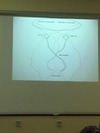Optics Flashcards
(20 cards)
1
Q
Ishihara Color test
A
- is a test for red-green color deficiencies
- the tests consists of a number of colored plates called Ishihara plates, each of which contain a circle of dots appearing randomized in color and size
2
Q
Hyperopic(Longsightedness)

A
- means the closer an object is, the more blurred it appears uncorrected, hyperopia bring on fatigue, sore eyes, headaches and eyestrain. The eye is too short in relation to its refractive power. The light rays intersect behind the retina, resulting in a blurred vision
- A lens for hyperopia is a converging or plus lens
3
Q
The Astigmatic eye- distorted vision
A
- a condition where there is a variation in the shape of the cornea. Rays of light pass trough the corneaon 2 planes-vertical and horizontal . In the astimagatic eye one corneal plane is steeper than the other, so that the rays of light do not come together at the same point. One point cen be in front of the retina, the other behind. Both can be in front of the retina, etc.
- A lens for astigmatism is a cylindrical lens. ie, it is not spherical in shape but has dofferent curvature in 2 directions.
4
Q

A
5
Q

A
6
Q
Myopia(Shortsightedness)
A
- condition where the eye is too long in relation to its refractive power. The light rays therefore intersect in front of the retina instead of on it. Blurred vision results. The further away the object observed, the more blurred it appears. Clear vision is limited to nearby objects. Shortsighted therefore means having good near vision but poor distance vision.
- A lens for myopia is a diverging or minus lens
7
Q

A
8
Q
Common Vision Effects

A
- The picture shows what is known as an emmetropic eye. ie it has sharply focused vision at all distances
- In emmetropic eyes the refractive power of the cornea and lens is exactly matched to the length of the eye. Light rays are deflected in the eye in such a way that they fall exactly on the retina, producing a sharp image
- With the aid of its crystalline lens, the eye can adapt to all distances in much the same way as a zoom camera lens. This process is known as accomodation
9
Q
Rhodopsin
A
- The rods employ a sensitive photopigment called rhodopsin
10
Q
Visual acuity or resolution
A
- While visual acuity or visual resolution is much better with the cones, the rods are better motion sensors. Since the rods predominate in the peripheral vision, that peripheral vision is more light sensitive, enabling you to see dimmer objects in your peripheral vision
11
Q
Rods
A
- The rods are more numerous of the photoreceptors, some 120 million and are the more sensitive than the cones. However, they are not sensitive to color. They are responsible for our dark-adapted or scotopic vision. The rods are incredibly efficient photoreceptors. More than one 1000 times as sensitive as the cones, they can reportedly be triggered by individual photons under optimal conditions
12
Q
Cones
A
- are less sensitive to light than the rods, as shown a typical day-night comparision. The daylight vision(cone vision) adapts much more rapidly to changing light levels adjusting to a change like coming indoors out of sunlight in a few seconds
13
Q
Current understanding of cones
A
- Current understanding is that the 6 to 7 million cones can be divided into red cones(64%) , green cones(32%) and blue cones (2%) based on measured response curves.
- They provide the eye’s color sensitivity. The green and red cones are concentrated in the fovea centrails. The blue cones have the highest sensitivity and are mostly found outside the fovea leading to some distinctions in the eye’s blue perception
14
Q
3 Different Types of color reception
A
- The experimental evidence suggests that among the cones there are 3 different types of color reception
- Response curves for 3 types of cones have been determined. Since the perception of color depends on the firing of these 3 types of nerve cells, it follows that visible colorcan be mapped in terms of 3 numbers called tristimulus values
- Color perception has been successfully modeled in terms of trisimulus values and mapped on the CIE chromaticity diagram
15
Q
The major problem in visual perception
A
- The major problem in visual perception is that what people see is not simply a translation of retinal stimuli(ie, the image on the retina). Thus people interested in perception have long struggles to explain what visual processing does to create what we actually see
16
Q
The lens of the eye
A
- The lens of the eye focuses light on the photoreceptive cells of the retina, which detect the photons of lightand respond by producing neural impulses. These signals are processed in a hierarchical fashion by different parts of the brain, from the retina to the lateral geniculate nucleus, to the primary and secondary visual cortex of the brain
17
Q

A
18
Q

A
19
Q

A
20
Q
A


